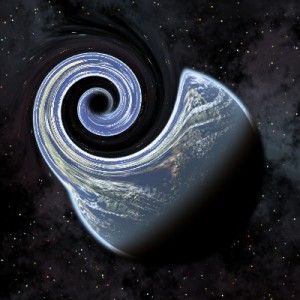Who’s Afraid of the Big Black Hole?

Are we feeling scared yet?
Professor John Billingsley is the guest-writer of this article. He is a Professor of Engineering at the University of Southern Queensland.
He has yet to engineer a Black Hole – but if he does, he tells us we’ll be the first to know.

 Prepare to meet your dddddooommm
Prepare to meet your dddddooommm
They lurk in the centres of galaxies, gobbling up suns and planets with a voracious appetite. Come near one and you are either doomed or spat out into a different time or dimension.
… Or so the science fiction writers would have us believe. And many of the documentary writers who ought to know better have a love for the lurid rather than adherence to the truth.
Turning to Logic
But just what is the truth? What can we deduce about Black Holes by cold scientific logic? To find out, we have to try to warm up a bit of cold science.
Some theories, such as Relativity, are constructed on the basis of unexpected observations. Others arise from a process of “What if?” The Black Hole is one of the latter. To see how ‘What if’ can lead to ‘Black Hole’ we will need to do some ‘dimensional analysis’. That sounds impressive but we’ll try to keep it light. We’ll stick with ‘Newtonian’ physics and for now ignore the arguments of relativity, curved space and all the other gizmos.
By Newtonian reasoning
Now it is no surprise to you (as an experienced student of science) that volume is proportional to the third power of length. You have to stack eight one-metre cubes together to make a two-metre cube. So if you double the size of a planet while keeping the density the same, you will multiply its mass by a factor of eight.
Next we call on two theories which are well supported (or in other words these are theories which are propped up by heaps of observations). The first is the theory that gravity is inversely proportional to the square of the distance from the centre of a planet (unless you tunnel underground). The second is that gravity is proportional to the mass of the planet. So on a double-sized Earth, the mass would be up by a factor of eight, but the distance would be doubled, resulting in gravity that is multiplied by eight but then divided by four, to give a result that is simply double that of Earth.
Testing this out
Can we test this by observation? Of course. We have visited the Moon (well, not I personally, nor you probably, but astronauts have done so.) If we believe the astronauts’ gravity on the Moon is one sixth of that on Earth. The diameter of the Moon is one sixth of that of the Earth, so the argument works, provided the Moon has density roughly equal to that of the Earth.
But what would happen if we could squash the Earth to half its size, while keeping the mass constant? The radius would be halved, gravity at the new surface would be increased by a factor of four, but to get there we would have to squash everything to eight times the density. Could this be possible?
Off into Orbit
Let us do some dimensional analysis on the Earth’s ‘escape velocity’. To keep the maths as easy as possible, we’ll consider the case of an object in in low orbit. In that case, the orbital velocity (the ‘speed’ of its orbit) is 0.7 of the ‘escape velocity’, the speed needed to take an object right out of the gravitational field.
OK, keep hold of your hat, because the maths speeds up at this point. If it’s too much to take in while you’re reading fast, skip read the next paragraph for now and take your time with this bit later.
Now ‘centripetal acceleration’ (the correct thing to say instead of ‘centrifugal force’) is proportional to the square of the speed, divided by the radius of the circular orbit. The acceleration of gravity is inversely proportional to the square of the orbit’s radius, so for something to stay in orbit they must be equal, v2 / r = k / r2. So when orbiting the same mass, the square of the speed is inversely proportional to the radius … So for our squashed Earth, we would set off from half the radius and therefore need 1.4 (the square root of 2) times the escape velocity.
But – surely we’re not meant to be able to escape?
But what is all this about escape velocities? The idea of a Black Hole is that it is something so big or so dense that to escape from it, something would have to set off at the velocity of light.
It’s a good point. Our next step will be to investigate the size of the danger. If we want to turn the Earth into a black hole by squashing it, how small must we make it?
By visiting the NASA website, we find out that the escape velocity of the Earth is around 11 kilometres per second. The velocity of light is 300,000 kilometres per second. So that is nearly 30,000 times as fast. We would have to squash the radius by the square of this number, that is nine hundred million, to make a Black Hole. That would take the radius from six million metres (6,000 km) to just six millimetres or so, a mere pebble.
Let me just make sure you’re following then. So the idea now is that instead of the Earth, we could have a pebble-sized Black Hole and this will produce the same gravitational field as long as you are sufficiently distant.
We’re getting to the CRUNCH of the matter now
Now, how dangerous and hungry would this new black hole be? Suppose that we are flying past it in our spaceship, falling towards it from deep space with enough sideways speed to miss it. Can it ‘suck’ us to an awful doom?
If we are going to miss it by 400,000 km the spaceship’s speed will there be 1.4 times the orbital speed of the Moon. There is no way that we could tell from the motion that the Earth had been squashed.
If we miss by 7,000 kilometres our trip will still be no different from a fly-by of an unsquashed Earth. But suppose that we miss by just 5,000 kilometres.
We could fly by the black hole with no discomfort, but if the Earth had not been compressed we would be buried deep in a mountainside. Far from being more dangerous, the black hole would be a lot less dangerous than the original planet.
Can it EVER be a danger?
Of course there is a limit to how close we could get. With gravity varying inversely with the square of the distance, at a distance of six kilometres we would weigh a million times as much – if we were not in ‘free fall’ so that we sensed no weight. But if our feet were just a metre closer, they would be pulled by an extra one-third of their usual weight. We would be uncomfortably aware of a ‘gravity gradient’ pull between our head and our feet. Only if we were close to the centre of gravity of the spaceship would we have a hope of swinging back out into space without being squashed against the bulkhead.
But that possibility of escape means that the target area for a fatal crash is only one millionth of what it would be for an unsquashed planet. The only real danger of falling right into a black hole is that of colliding with something coming the other way.
So since the major property of a Black Hole is its gravitational field, we now see that we can happily mingle them amongst the luminous stars with no superstitious fear.
Ah, but I sense that some readers refuse to be dismayed. We’ve heard (they say) that a Black Hole could be used as a way to burrow through time. Sorry to disappoint but the idea that you can travel through time by diving into a black hole is patently ridiculous. Your mass would be transformed into kinetic energy as if it were a detonating hydrogen bomb. Long before that, your head would have been dragged from your neck by gravity gradient. Even your atoms would cease to be atoms, joining the neutron soup or contracting into an infinitely dense singularity. There would be no coming back.
Beware … of implausible ideas!
There are theories by the thousand, most of them in conflict with each other. Beware of believing that a claim must be true just because it is spectacular and gives the Disney Corporation inspiration.
(with thanks to guest-writer, Prof John Billingsley)